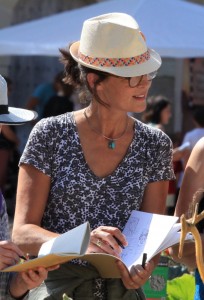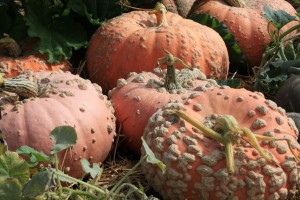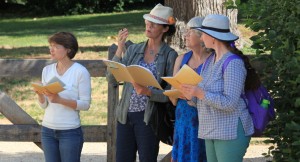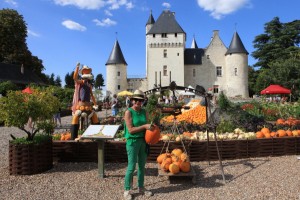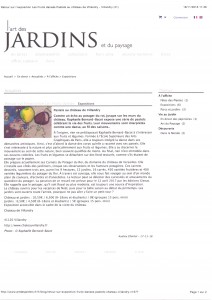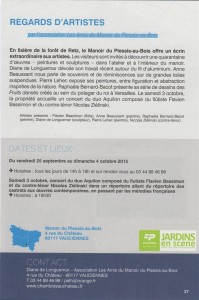2023
Echoes in the media
- Advertisement for the book “Jardins ouvriers jardins de demain” in Rustica pratique Summer 2023
(See the advert)
- Advertisement for the book “Jardins ouvriers jardins de demain” on the Hortus Focus website
(Go to the website, in French)
- Interview on WEO: “Jardins ouvriers, la nécessité du plaisir”, June 2 2023
(Watch the interview, in French)
- Advertisement for the book “Jardins ouvriers jardins de demain” in Famille Chrétienne n°2367
(See the advert)
- Interview on France Bleu Nord, 25 May 2023
(Listen to the interview, in French)
2022
Echoes in the media
- Interview in the programme “De Versailles à Orléans : l’assiette du Roi, pithiviers et andouille de Jargeau” on France Bleu, August 11
(Listen – In French)
- An article in “La nouvelle république”, of June 10
(Read the article – In French)
2021
Echoes in the media
- An article in n° 138 of the “Versailles +” magazine, of July 2021 (in French)
(Click to read)
2020
Interview on TV78
Interview on the Yvelines TV channel, TV78.
(In French)
Echoes in the media
- An interview on France Info on September 29
(Listen – In French)
- An article in the magazine L’Ami des jardins et de la maison of September 2020
(Read the article – In French)
- An article in the Courrier Picard of July 10
(Read the article – In French)
- Review (in French) by Paula Boyer, from La Croix newspaper, June 2020:
City gardeners in … watercolors
“Today’s city dwellers are increasingly interested in the garden, and even in the vegetable patch. More and more of them want to practise gardening even though they live in the city. But who are these urban gardeners? To discover their secret motivations, Raphaèle Bernard-Bacot went to meet them, sketchbooks and watercolor brushes in hand. She thus went from garden to garden, to Paris and its nearby suburbs, observing, most often in silence, these men and these women bent over their hoe or their spade.”
(Read more on her blog – In French)
- On RMC on July 25, in the Weekend Experts – Your Garden, by Patrick Mioulane
- Review by Alexandra Oury, freelance literary journalist
Editor’s summary: “A poetic and artistic stroll through the urban vegetable gardens, for garden and nature lovers.” The health crisis and confinement have made the gardens – and at fortiori in the urban space – even more precious than before. For those who were deprived of garden , their lack of nature was often felt; for the others, it was able to act as a refuge, a reserve of oxygen, a source of food, a diversion while waiting … The fact of being able to “consume local” had probably never seemed so important and useful until this difficult time. Gardeners of the cities – Portraits sketched on the spot (Editor Rue de l’Echiquier) is the fruit of two years of work during which Raphaèle Bernard-Bacot became interested in these men and women. These gardeners come from very diverse backgrounds. They have not waited for the crisis to understand the value of the surviving corners of nature, at the heart of our cities. “To discover the gardeners secret motivations”, RBB indicates in her foreword, “I went to meet them, not to question them, but to draw them. I went for walks with my notebooks, from garden to garden, to Paris and its suburbs, and I picked up some great stories that could inspire us.”
(Read on her blog – In French)
- Brief in Télérama from June 24
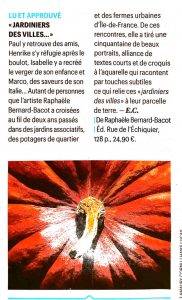
- An article in the magazine Flow of September 2020
(Read the article – In French)
- Review in n° 126 of the “Versailles +” magazine, of May 2020 (in French)
- Georges Lévêque: L’aquarelle au jardin
(Read on his blog – In French)
2019
Raphaèle Bernard-Bacot,
the artist and author who sketches the gardens
Raphaèle Bernard-Bacot spends most of her time drawing fruits, vegetables and plants. She invites people trough nomadic workshops to learn how to sketch on the spot and especially how to see in a different way.
Raphaèle Bernard-Bacot found herself too alone in her studio. This artist, trained at the Ecole Supérieure d’Arts Graphiques in Paris. She wanted to transmit her passion for drawing, but also for nature, which she grasped with the seasons, notably at the King’s Vegetable Garden in Versailles*. She offers nomadic workshops in the most beautiful gardens, requested by the comittee of Versailles or the Château du Rivau in Touraine, or the gardens of the five senses in Yvoire in Savoie.
“Instead of visiting a garden as a tourist, I suggest visitors to see differently by providing them with a notebook, pens, and watercolors. I invite them to ask themselves to pause and change their relationship to time.” This is a condensed drawing class, where Raphaèle gives instructions for learning how to frame the image, capture the light, and fix a line. But it is above all, a state of mind, that assists one to marvel at the beauty of the landscapes, and to understand the prodigious process of growth of a plant, a flower, or a fruit.
“Many of those who follow my workshops, need to get closer to the earth,” says Raphaele. The students, surprised by the results of their sketches, realize that they have looked at things that they have never seen before and become more confident. Neither botanist, gardener, or simple walker, Raphaèle Bernard-Bacot argues for intelligent tourism, with her artistic sensitivity.
Raphaèle started by drawing dancers in a very fast pace . “Following movement was a wonderful training for me,” she said . Now she wants to change her rhythm in life and in art.
Raphaele says in her book, while stumbling over a quince in her own garden, “all the soil of my childhood suddenly came to the surface: my grandparents’ vegetable patch, my favorite field of exploration, where pumpkins were climbing to assault pear trees. An incomparable fragrance exhaled from the fruit tree where apples and pears were stored . A paradise!”
The artist then sets out to draw “Fruit Dances,” a talented way of placing them in space, but also of warding off their perishable nature. “Hour by hour I see leaves wilting. The vegetables are alive, I always draw the entire plant, with the root and the leaves, and draw them as quickly as possible to keep their freshness and color intact.”
The landscape designer thinks of the nuances of lichen color, of the orange palette of pumpkins …. “Ah! If people looked more at nature with their eyes, rather than through the computer screens, if they paid attention to the extraordinary quantity of colors present before us -” This wonder of the artist in front of Creation and her work in the heart of the gardens changed her life.
Raphaèle now cultivates her mini-vegetable garden. She has become a member of the association of Incroyables Comestibles from her village. She first spends time in the former workers’ vegetable gardens, then she moved onto all kinds of different community gardens, with the aim of publishing a book of drawings on those. She gathered fifty-four different portraits of city gardeners.
The garden remains a wonderful space for exploring the bond that continues to unite mankind to the earth, even in the city.
PELERIN n°7113, 28 mars 2019
(Click on the image)
2018
- Georges Lévêque : Du château de Versailles au château du Rivau (in French)
- Château du Rivau (Rivau Castle)
- Georges Lévêque : Trois siècles de légumes et de fruits en aquarelle (in French)
DU CHATEAU DE VERSAILLES AU CHATEAU DU RIVAU | Georges Lévêque Jardins
A deux pas du Château de Versailles, à proximité immédiate de la Cathédrale Saint-Louis, le Potager du Roi est un lieu d’enseignement, tout autant qu’un site d’expérimentation et de transmission. Aujourd’hui cultivé par l’Ecole nationale supérieure du paysage, il offre à ses étudiants promis au métier de paysagiste, à ses jardiniers et à ses visiteurs une accumulation de sensations diverses fort réjouissantes. La dessinatrice Raphaèle Bernard-Bacot s’y est promenée en toute saison et en toute liberté pour croquer fruits et légumes. Son carnet de voyage a été publié par les Editions Glénat en 2017 « Le Potager du Roi, dessins de saison à Versailles ».
Le carnet dessiné raconte un voyage qui a duré trois ans et qui décline les neuf hectares faits de différents jardins et carrés et qui comptent au minimum 450 variétés fruitières et 400 variétés légumières. Formée à l’Ecole supérieure des arts graphiques Penninghen à Paris, Raphaèle a d’abord mis la danse au coeur de son travail d’artiste, avec des années passées au contact des danseurs et des chorégraphes. Depuis 2012, c’est au rythme des saisons que mûrit son oeuvre. Elle s’est prise de passion pour les fruits, les légumes, les jardins en général, a découvert l’agroécologie et créé une série intitulée « Les fruits dansés ». Le Potager du Roi l’accueille depuis 2013 et elle continue d’y dessiner régulièrement. C’est ainsi que Glénat présente son auteur à la sortie du livre. D’où l’idée de l’inviter au Château du Rivau, lieu d’expositions et d’événements toujours hauts en couleurs. Doté d’un superbe potager, une création de Patricia Laigneau, l’expérience a eu lieu à l’occasion de la fête de la citrouille et du potager le 9 septembre dernier. Le Rivau avait confié à Raphaèle le soin de conduire un atelier nomade autour du potager en proposant aux visiteurs d’apprendre à croquer les légumes et l’ambiance du Potager de Gargantua. Voici comment elle définit son parcours artistique.
Raphaèle Bernard-Bacot
« En 7 ans, ma démarche artistique s’est transformée en expérience de vie. Je dessine les fruits dansés au pastel sur monotype (voir lien ci-dessous) avec une attention particulière aux fonds qui sont des fonds imprimés au monotype, avec des recherches de matières et couleurs. Dans un 2ème temps, je sélectionne le fruit ou le légume, à la fois décrit et suggéré avec un trait vif, souvenir de mon expérience avec les danseurs où il fallait dessiner dans l’urgence. Pour les fruits, il faut faire vite aussi car ils sont périssables. Quand je dessine un fruit dans son intégralité, racines et feuilles comprises, il reste un modèle vivant comme l’étaient les nus artistiques que j’ai pratiqués. Donc les fruits dansés en deux temps, d’abord le fond, travail long de recherche et expérimentation de peintre, puis le fruit, travail rapide au pastel. L’alliance des deux en fait une nature morte contemporaine en mouvement, d’où le nom de fruit dansé. Mon agent appelle ça du figuratif transitionnel, ça fait sérieux !
Potiron Galeuse d’Eysines
« En cherchant des fruits variés parfois rares, je découvre le Potager du Roi où on m’accorde l’autorisation exceptionnelle de venir sur place avec mon carton à dessin. Là, je fais des rencontres de jardiniers et de bénévoles. Approches à la fois concrètes, quand et comment ça pousse, mais surtout humaines. Le travail des jardiniers, comme celui des danseurs, est inestimable et incroyablement varié. Chacun cultive à sa manière, selon ses maîtres et les circonstances. Cela est passionnant et je commence à le restituer sous la forme d’un carnet de bord publié en 2017 par Glénat. C’est à la fois un travail de dessinateur, mais aussi botanique et littéraire. Je le prolonge aujourd’hui dans les jardins ouvriers, qu’on dit aussi familiaux, avec l’idée de faire un deuxième livre.
Atelier nomade de croquis au Château du Rivau
« L’Association des Amis de Versailles me contacte grâce au livre car elle cherche à faire une animation dessin. Je propose des ateliers nomades de croquis en choisissant des haltes qui correspondent à un point de vue particulier dans le jardin du Petit Trianon : une perspective, un massif, une plante, un détail. C’est à chaque fois une surprise visuelle que le promeneur ne voit pas forcément. Mais avec un crayon et un carnet, le temps s’arrête et le regard s’affine. Au Château du Rivau, il y a beaucoup de surprises qui amusent l’oeil, en plus de la beauté de l’architecture Renaissance et du jardin. Il y a des installations pleines d’humour et de poésie de la part des artistes invités par les propriétaires. J’aime partager cela avec les élèves et souhaite développer ces ateliers nomades de croquis ailleurs, car c’est vraiment un bon moyen pour visiter un lieu. Pour conclure, je me décris comme une artiste butineuse et infatigable qui aime partager son miel avec tous les amateurs de jardins potagers ou d’agrément. »
Patricia Laigneau au moment de la pesée des plus gros potirons et citrouilles
2017
TELEVISION
Reportage French channel France 3 Ile-de-France
CultureBox
PRESSE
Versailles +
September 2017
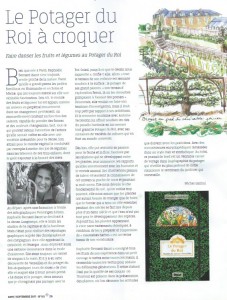
La libre Belgique
September 2017
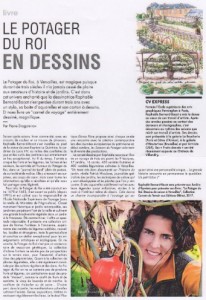
-
-
- LE PARISIEN
- FEMME ACTUELLE H.S JARDIN
- MARIE-FRANCE
- MODES ET TRAVAUX
- ARCHITECTURES A VIVRE
- NASHI
- L’AMOUR DES LIVRES
- VILLE D’AVRAY INFO
- LES NOUVELLES DE VERSAILLES
- LA DEPECHE DU MIDI
- MEMOIRE DES ARTS
- CONNAISSANCE DES ARTS
- VERSAILLES +
-
WEB (in French)
-
-
- Télérama – Fête des plantes de printemps
- Paris côté jardins – Livre : Le potager du roi
- 78actu – Elle croque les légumes du potager du roi
- Georges Lévêque – Trois siècles de légumes et de fruits en aquarelle
- Promo jardin – Edition : Le potager du roi
- Blog des arts – Livre : Le potager du roi
- Magazine Hortus – Les bonnes feuilles du mois de mai
- CultInfos – Versailles : le Potager du Roi “croqué” par les artistes et les jardiniers
- Decisionlocale – Versailles : le Potager du Roi “croqué” par les artistes et les jardiniers – Franceinfo
-
Patrick Mioulane: ” Le Potager du Roi “
Georges Lévêque Jardins: ” Trois siècles de légumes et de fruits en aquarelle”
Magazine Hortus Focus, le jardin à 360°: ” Le potager croqué “
2016
Château de Villandry exhibition
Friday, October 28, 2016: Presentation of the “Fruits dansés” exhibition in Villandry at the end of the TV show “Silence ça pousse”
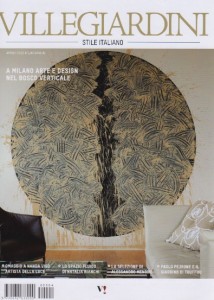
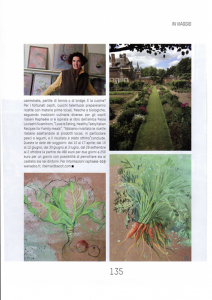
2015 Picardie
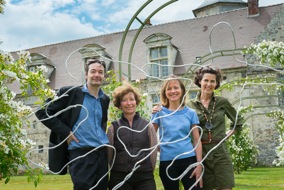
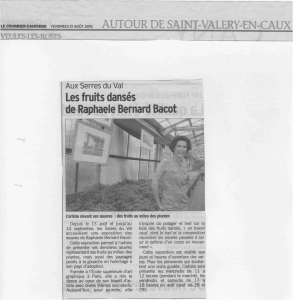
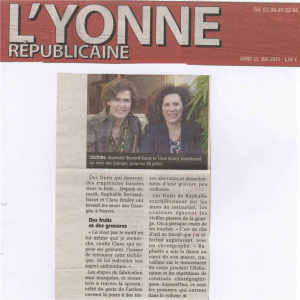
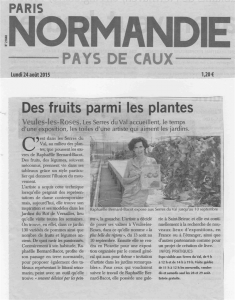
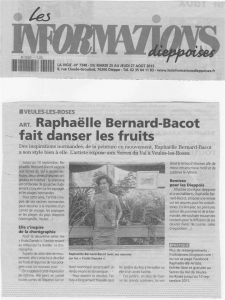
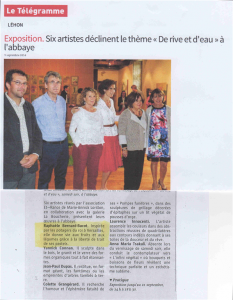
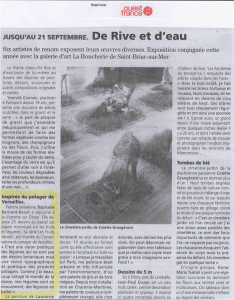
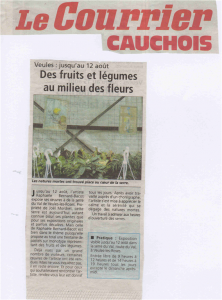
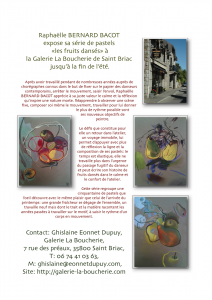
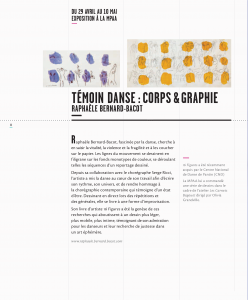
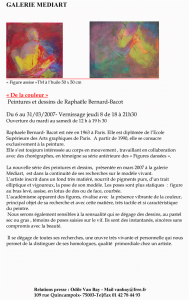
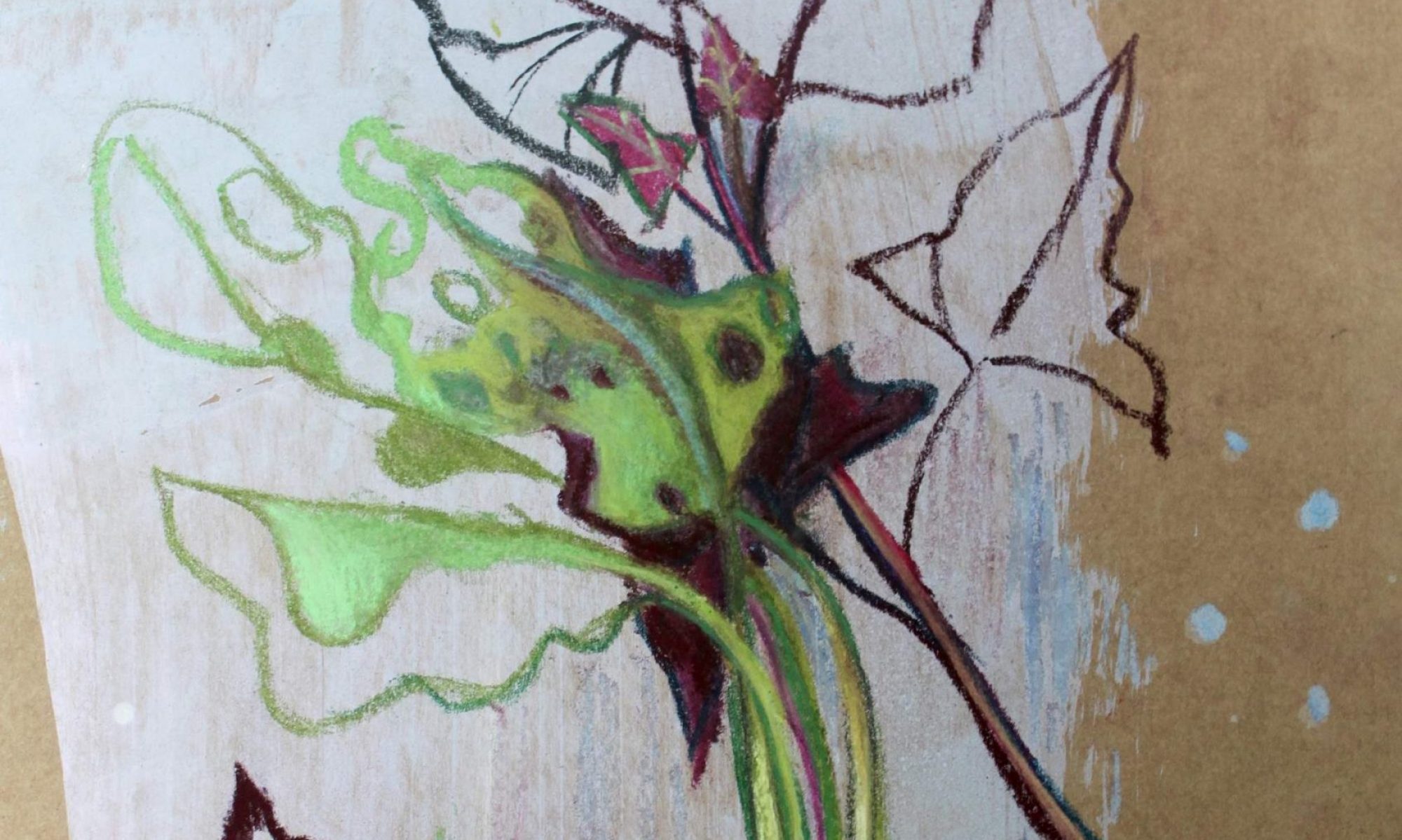
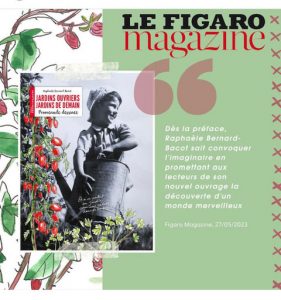
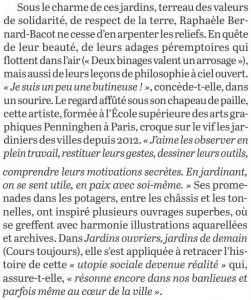
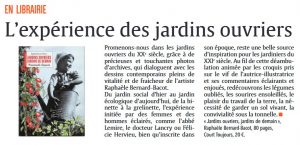
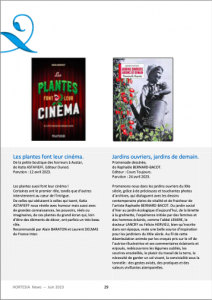

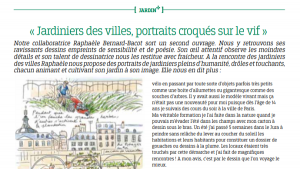
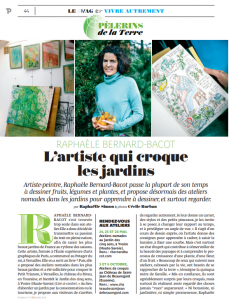
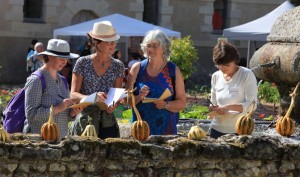
![001 POTAGER DU ROI[LIV].indd](https://www.rbernardbacot.com/wp-content/uploads/2018/10/POTAGER-DU-ROI-par-RBB-215x300.jpg)
